Industrial Photography
UV examination for metal fatique
17/06/14 12:35
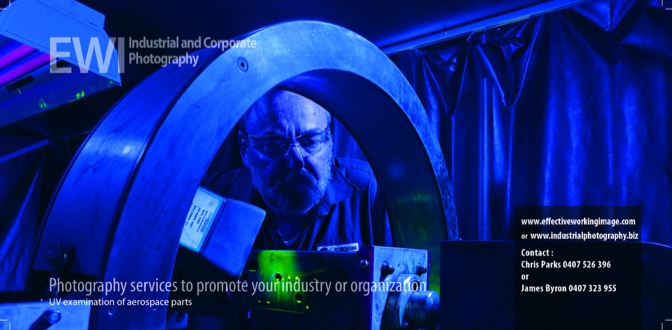
Photography of high performance manufacturing facility
Photographing for high performance companies brings fascinating success stories and challenging photographic situations. Many highly technical processes create real challenges for photographers.
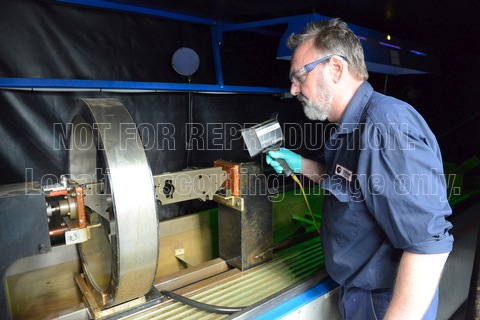
This location scouting image show what a normal smart camera would manage. Loosing
all the effect of the UV examination and dramatic possibilities it offer in our shot at top.
UV light is used in many areas including chemical analysis and examination of structural weaknesses. Our client is one that needs to find and repair high performance metals used in the aerospace industry. U.V. light causes phosphorescent materials to glow when used in a darken booth.
Photography in a small blacked out viewing booth with a light basically invisible to the human eye is pushing the limit far beyond most camera’s capabilities. Exposure times would be far to long for our examiner to be able to stay steady. Therefore we had to introduce coloured flash lights to replicate the effect the UV light produces but in amounts capable register in the camera.
At the same time we needed to set the camera on a steady tripod to record the glow of the UV tubes in the booth with a time exposure the operator could manage to hold. The green area is the phosphorescent material that highlights the stressed and damage areas. Leaving our colour geld flashes to light our operator and other parts of the cradle used to hold the piece to be examined.
Industrial photography lighting on the run, at 2 a.m.
04/05/14 18:44

Our project was to photograph a high tech, high capability, rail track welding unit. Capable of automated welding of rail track joints at far quicker rates than previously obtained.
Working while the track is not in service ( meaning late at night ). This large truck based unit can weld extensive lengths of track with stops of around 90 seconds to 2 minutes per weld. Before moving on around 250 meters to the next location.
The cost and time commitments our client was under meant we had to shoot within their work schedule. No time to stop just to make pretty pictures.
The light output from the welding head compared to the available light to shoot at around 2.00 in the morning would mean a whole lot of sparks and glare in one spot in and otherwise totally black frame. No detail in the truck, location and very little on the workers.
Even smart digital cameras find these conditions beyond their capabilities. And our clients certainly require a far more sophisticated result.
We obviously needed high powered, remote triggered flash units. Set up to light the rest of the equipment and workers.
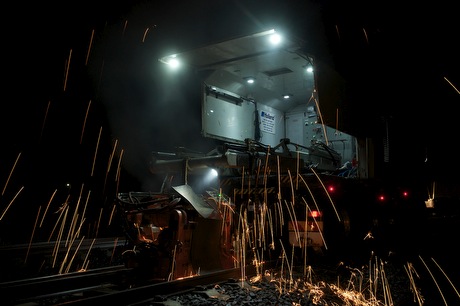 No additional lighting
No additional lighting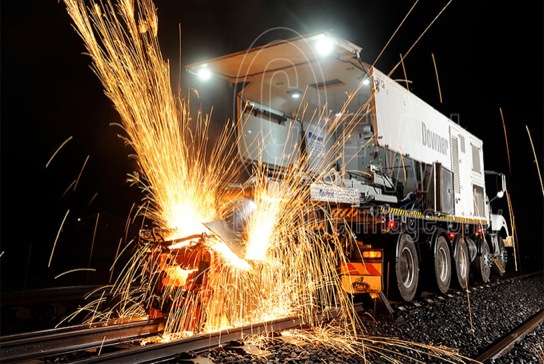
Additional strobe lighting lifts the unit out of the darkness
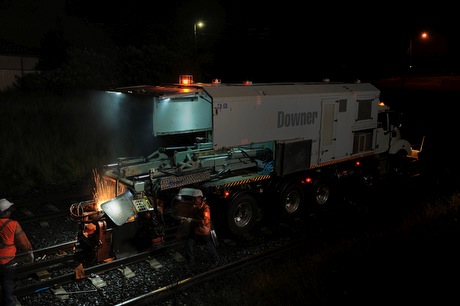 No additional lighting
No additional lighting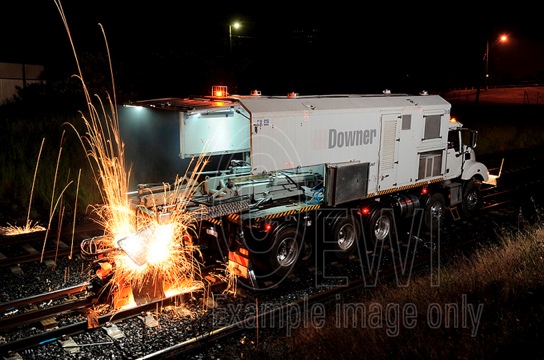
Additional strobe lighting lifts the unit out of the darkness
We arrived on site early to give ourselves time to checkout the possible location and workout our options. Only to find it starting to rain. The unit could not be used until that stopped. Nor could we set up and leave our high capacity flash units in the rain.
Eventually at around 2.00a.m. the rain stopped. The track was free of trains and our client’s work team was scrambling to make up for the lost time.
James having planned with the client what needed to be shot managed the camera side of the shooting. Chris worked on setting up the lighting units and making adjustment to positioning, direction and light levels as directed by James via sign language of our own particular sort, from behind the camera.
2 minutes later the unit was off to it’s next location 250 meters down the track. We where gathering camera, tripod, lens, light stands and lights. To make our way in the dark to its next stop and our only other opportunity to nail some additional shots.
It was a rush in more ways than one. So as we finally packed away the gear at around 4.00 a.m. Coffee at any outlet we could find at that time of the morning before going on to a new days work seemed very appealing. It was a good nights work and an exciting challenge with satisfying results for everyone.
Got a challenging photographic requirement ? Challenges accepted !
Industrial photography outside the normal 9 - 5
19/03/14 13:03
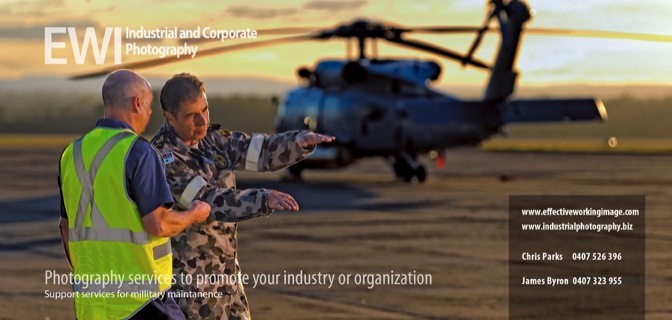
Photographing with early morning and late afternoon light was part of our plan for a series of images for our client, who offers maintenance support in the aviation, aerospace and military sectors. It means longer shooting days for us but allows for far more interesting results visually. Any business looking for photography with impact should allow for their photographer to have this option. Any photographer of professional standing should revel in the opportunity. The extra organising and time to have someone on hand will prove extremely worthwhile.
Industrial and architectural photographers use these “ Magic times of day “ when ever possible to add colour, sculptural lighting and richness to their shots. These times of day can also help separate the prime subject matter from less desirable background items. It also can make the bland exciting.
But it does often add complication to the actual shooting of the shot. With main foreground subject matter silhouetted against bright skies or even the setting Sun, shadows become a major problem. Light levels change fast, dropping rapidly as the Sun goes lower in the sky. Any clouds can further drop light levels to a quarter and less. Or raise them by the same amounts in moments.
However when treated properly with additional lighting, capable of matching if not over powering the daylight, the results can be truly arresting. Just what any business needs to standout from the competition.
Where the art comes in is in not overdoing the additional lighting so much that the final image looks totally unbelievable. Constant adjusting of both daylight and additional lighting is required as the light quickly changes. Careful placement of lights to create believable effects is critical.
While most higher end amateur cameras can add some light to compensate for shadow areas. They do so from the camera’s angle of view, which often clashes with the angle of the natural light. They can light only over very short distances. And they take much of the exposure controls for the background light conditions out of your control. Creating a fill light which is total inconsistent in colour and direction with the rest of the image.
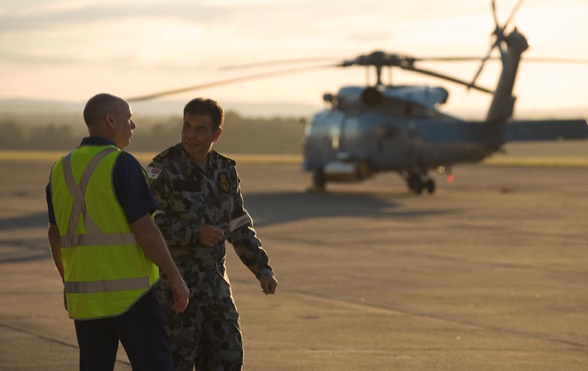
Above is an early shot to get rough positioning prior to adding our additional lighting.
And a direct comparison with and without our specially balanced and Geld additional lighting.
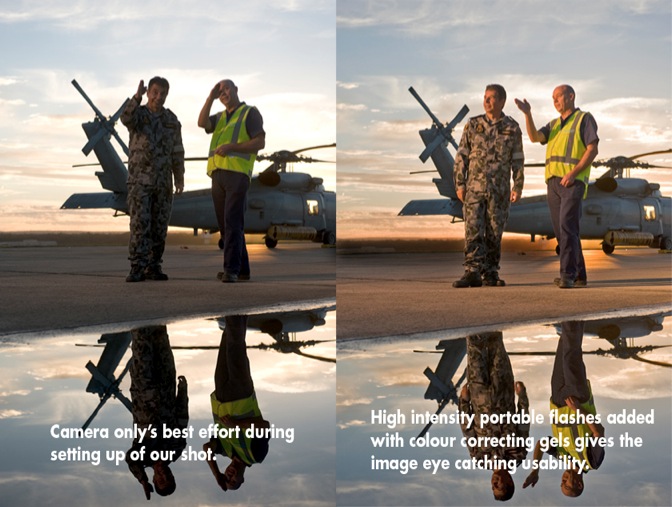
Working quickly as a team Chris & James where able to set up and shoot additional well lit options in the fast fading light.
Mining industry ore storage shed
21/10/13 14:42
An experienced industrial photographer brings a new creative eye to what you may consider same old, same old.
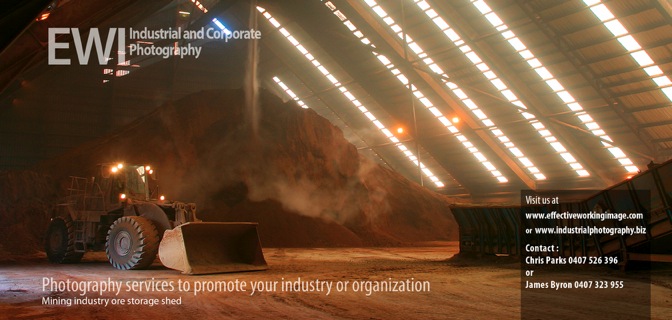
This shed was not on the schedule to be photographed because the client considered it just a dark and dirty location that they saw and took for granted every day. But the top to bottom slopping skylights created beautiful light and strong eye catching graphics within this image.
By carefully positioning the front end loader on the opposite side of the frame it brought the eye back from the skylight and holds it within the shot. Then one starts to discovery the richness of tones and detail in the stockpile and the cascade of material falling from the feeder at the top. It also helps to indicate the shear size of the shed and therefore the operation.
Luckily our client was happy to allot some time to show us around the whole plant and allow us to have a quick look in even the most mundane of places to his mind. By adding a little of our own lighting to help pick out the front end loader we where able to come up with a much liked shot they had not even considered workable.

This shed was not on the schedule to be photographed because the client considered it just a dark and dirty location that they saw and took for granted every day. But the top to bottom slopping skylights created beautiful light and strong eye catching graphics within this image.
By carefully positioning the front end loader on the opposite side of the frame it brought the eye back from the skylight and holds it within the shot. Then one starts to discovery the richness of tones and detail in the stockpile and the cascade of material falling from the feeder at the top. It also helps to indicate the shear size of the shed and therefore the operation.
Luckily our client was happy to allot some time to show us around the whole plant and allow us to have a quick look in even the most mundane of places to his mind. By adding a little of our own lighting to help pick out the front end loader we where able to come up with a much liked shot they had not even considered workable.
Don't be afraid of the dark
12/08/11 06:23
Most photographers are always scratching around for more light so they can achieve good exposures. A well light shot is claimed to be when one has tonal range throughout the shot within accepted technical limits. As an industrial photographer I’ve learnt there are some location that are just beyond lighting. Either they are to vast. To busy or simply incapable of shutting down simple so some pesky photographer can place lights everywhere.
Some locations are dark, dirty, dangerous and stunningly good for some fantastic, punchy photography. The images below are a case in point.
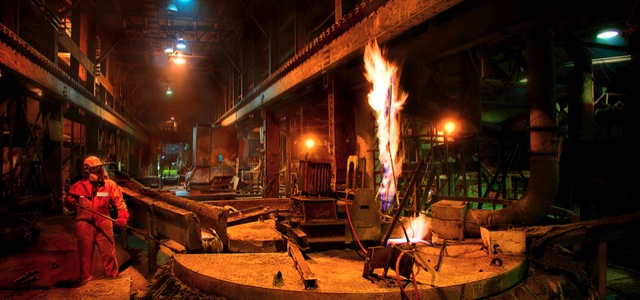
These shots are some from a days shooting done in a huge metal foundry. In fact the largest lead producer in the world.
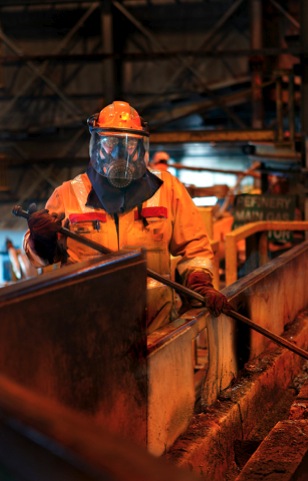 This is the sort of place where everybody is very worried about the safety and risk of disruption from visitors being on site. It is full of very big, dangerous pieces of equipment rumbling around. Molten metal flowing or being poured, flames, toxic fumes and in this case the possibility of microscopic lead particles in the air. Safety procedures are extensive and totally non-negotiable. Photographer needing to look through a viewfinder or not, you wear ALL the safety gear just like the guys on the job, NO EXEMPTIONS ! Breathing ventilator, safety glasses as well as Screen on the helmet, neck protection, fire resistant overalls, the works. You go nowhere or set up anything without your escorts permission and close company. The noise is constant and ear protection is also mandatory so its hard to communicate.
This is the sort of place where everybody is very worried about the safety and risk of disruption from visitors being on site. It is full of very big, dangerous pieces of equipment rumbling around. Molten metal flowing or being poured, flames, toxic fumes and in this case the possibility of microscopic lead particles in the air. Safety procedures are extensive and totally non-negotiable. Photographer needing to look through a viewfinder or not, you wear ALL the safety gear just like the guys on the job, NO EXEMPTIONS ! Breathing ventilator, safety glasses as well as Screen on the helmet, neck protection, fire resistant overalls, the works. You go nowhere or set up anything without your escorts permission and close company. The noise is constant and ear protection is also mandatory so its hard to communicate.
All that said this is a location that simply because of the dirt, darkness, complexity and shear size make striking results always possible.
But before you go snapping away remember your choice of angle, lens selection, positioning of your subject and handling of your equipment can compromise all the efforts your client has implemented to keep the operation safe and productive.
Just like with the old master painters. The selective use of lighting to pick your subject out from the dark backgrounds create great impact and allows for richness in contrast and colour. ENJOY !
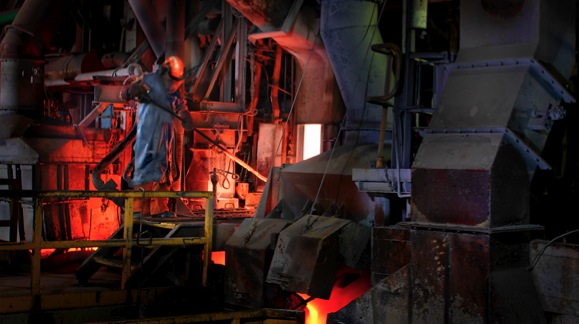
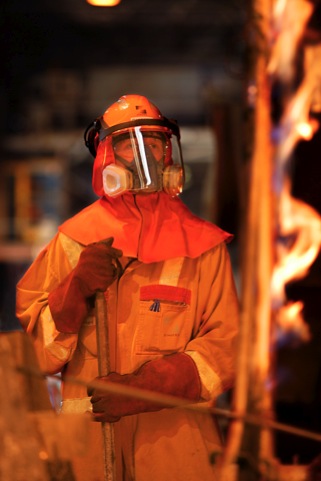
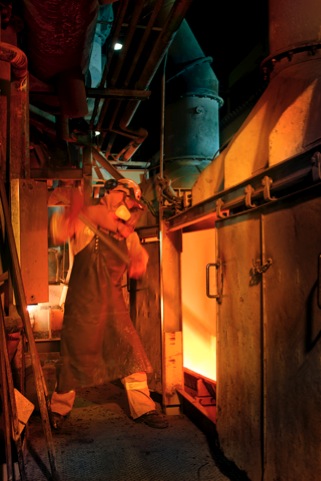
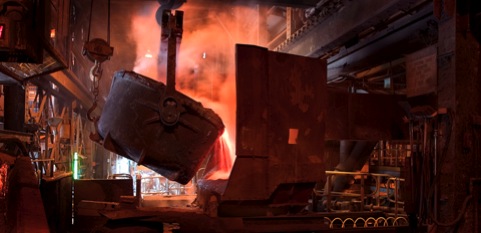
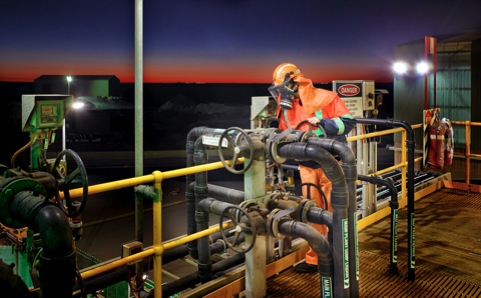
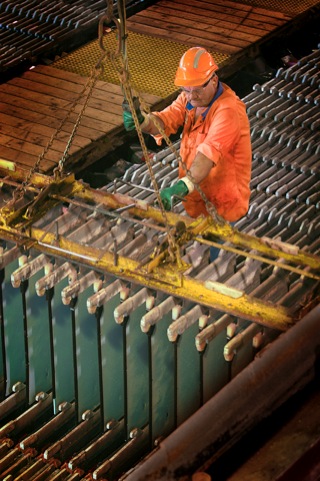
Some locations are dark, dirty, dangerous and stunningly good for some fantastic, punchy photography. The images below are a case in point.

These shots are some from a days shooting done in a huge metal foundry. In fact the largest lead producer in the world.

All that said this is a location that simply because of the dirt, darkness, complexity and shear size make striking results always possible.
But before you go snapping away remember your choice of angle, lens selection, positioning of your subject and handling of your equipment can compromise all the efforts your client has implemented to keep the operation safe and productive.
Just like with the old master painters. The selective use of lighting to pick your subject out from the dark backgrounds create great impact and allows for richness in contrast and colour. ENJOY !





